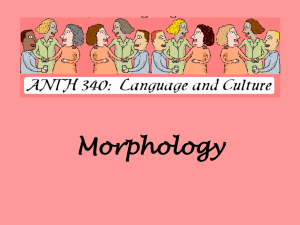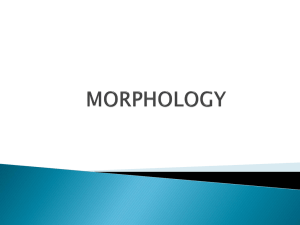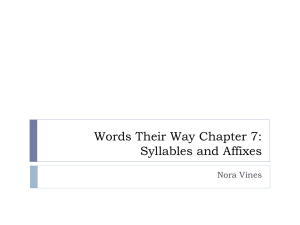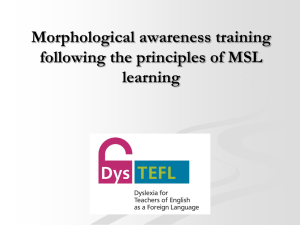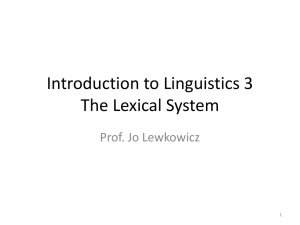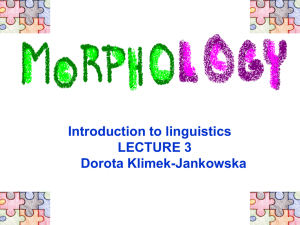Issues in Linguistics 1. Which of the following is not among the four
advertisement
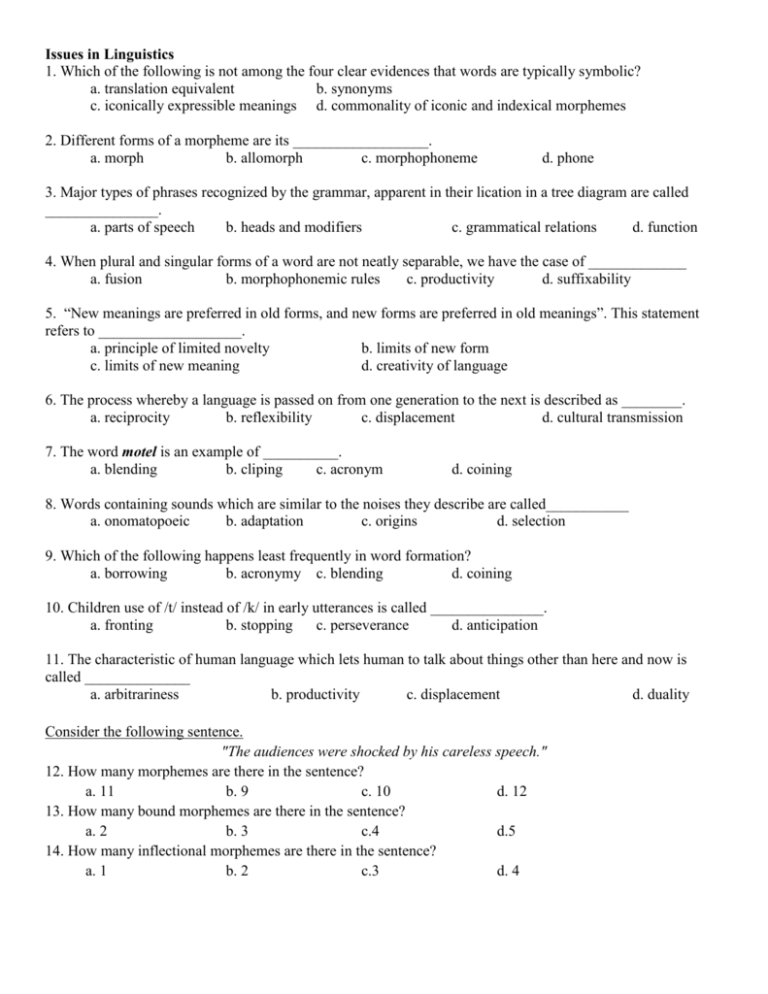
Issues in Linguistics 1. Which of the following is not among the four clear evidences that words are typically symbolic? a. translation equivalent b. synonyms c. iconically expressible meanings d. commonality of iconic and indexical morphemes 2. Different forms of a morpheme are its __________________. a. morph b. allomorph c. morphophoneme d. phone 3. Major types of phrases recognized by the grammar, apparent in their lication in a tree diagram are called _______________. a. parts of speech b. heads and modifiers c. grammatical relations d. function 4. When plural and singular forms of a word are not neatly separable, we have the case of _____________ a. fusion b. morphophonemic rules c. productivity d. suffixability 5. “New meanings are preferred in old forms, and new forms are preferred in old meanings”. This statement refers to ___________________. a. principle of limited novelty b. limits of new form c. limits of new meaning d. creativity of language 6. The process whereby a language is passed on from one generation to the next is described as ________. a. reciprocity b. reflexibility c. displacement d. cultural transmission 7. The word motel is an example of __________. a. blending b. cliping c. acronym d. coining 8. Words containing sounds which are similar to the noises they describe are called___________ a. onomatopoeic b. adaptation c. origins d. selection 9. Which of the following happens least frequently in word formation? a. borrowing b. acronymy c. blending d. coining 10. Children use of /t/ instead of /k/ in early utterances is called _______________. a. fronting b. stopping c. perseverance d. anticipation 11. The characteristic of human language which lets human to talk about things other than here and now is called ______________ a. arbitrariness b. productivity c. displacement d. duality Consider the following sentence. "The audiences were shocked by his careless speech." 12. How many morphemes are there in the sentence? a. 11 b. 9 c. 10 d. 12 13. How many bound morphemes are there in the sentence? a. 2 b. 3 c.4 d.5 14. How many inflectional morphemes are there in the sentence? a. 1 b. 2 c.3 d. 4 15. What is the major difference between inflectional and derivational morphemes? Derivational morphemes _________ a. carry the main content of the messages but inflectional morphemes do not. b. can stand by themselves but inflectional morphemes can not. c. change the type of the word they attach to but inflectional morphemes do not. d. are limited in number but inflectional morphemes are not 16. A noun phrase immediately dominated by the verb phrase of a deep structure is the _________. a. subject of that verb phrase c. object of a dependant clause b. object of that verb phrase d. subject of an independent clause 17. We can generate an infinite number of sentences with a finite number of _________rules. a. morphophonemic b. phrase structure c. transformational d. hierarchical organization 18. Which of the following rules is true about the second VP in Ali knows that Reza eats apples? a. VP V CP b. VP V NP c. VP V (NP) (NP) d. VP V NP (S) 19. The sentence "The man is too old to harm" is ambiguous because it __________. a. cannot be negated c. has two possible deep structures b. has more than one surface structure d. is an embedded sentence 20. The semantic requirements of a verb for its complements are referred to as _____________. a. subgategorization b. semantic features c. category selection d. S-selection 21. Which of the following contains more than one free morpheme? a. uninteresting c. blackboard b. restlessness d. teachers 22. Loan translation is a type of __________. a. compounding b. deriving c. clipping d. borrowing 23. It is generally the case that there is no ‘natural’ connection between a(n) ___________ form and its meaning. a. linguistic b. arbitrary c. cultural d. communicative 24. In child language acquisition the first words children articulate have the syllable structure of _______. a. VC b. CVCC c. CCV d. CVCV 25. Such examples as bringed, goed, runned indicate that children ___________ morphological rules which they have acquired. a. overextend b. overgeneralize c. ignore d. generalize Theories of second language teaching 1. Which of the following is not among the functions of output? a. noticing b. hypothesis testing c. comprehensible output d. metalinguistic 2. ‘An input-governed system characterized by a serial movement of information from the lower to the higher levers’ is called _____________ processing. a. bottom-up b. top-down c. parallel d. interactive 3. One’s ability to consider language not just as a means expressing ideas or communicating with others, but also as an object of inquiry is referred to as ___________________. a. linguistic knowledge b. metalinguistic knowledge c. pragmatic knowledge and ability d. discourse competence 4. The corpus of utterances that learners actually produce orally and in written is referred to as ____________. a. intake b. input c. output d. intake processes 5. What helps learners derive working hypothesis about syntactic, semantic and pragmatic aspects of the target language is ________________________. a. inferencing b. controlled processing b. structuring d. central processing unit 6. The mismatch between the inputs we receive from our environment and what we acquire in a short time in first language acquisition refers to _____________. a. logical problem of language acquisition b. richness of linguistic environment c. the importance of exposure d. the significance of intervention 7. “A progressive inefficiency of the organism” is proposed in within the ______________ intake factor. a. individual b. affective c. environmental d. tactical 8. When anxiety impacts on the initial representation of the items in memory, its effect is on ________. a. output b. intake c. input d. task-related cognition 9. Which of the following concepts is in a contrast with the other three concepts? a. speech act theory b. functionalism c. communicative competence d. monocompetence 10. The input with the target feature made salient to the learners, for example, by means of emphatic stress, bolding, etc. is called ______________ input modification. a. product-oriented form-based b. process-oriented form-based c. comprehension-based d. form and meaning based 11. Which of the following concepts is referred to as sets of options in meaning that are available to the speaker-listener in social context? a. poverty of stimulus b. meaning potential c. interpersonal metafunction d. innateness 12. Regarding Hymes’ acronym SPEAKING, which of the following concepts refers to the channel and the code? a. instrumentalities b. norms c. genre d. acts 13. Within speech act theory, locution means ________________. a. intended meaning b. propositional, literal statement c. expected response d. pragmatic meaning 14. “A systematic body of ideas, organized from a particular point of view” refers to ______________. a. discourse b. system c. context d. ideology 15. “Formulaic aspects of language such as the oral speech acts or the written rhetorical aspects of language” refers to _________________ competence. a. actional b. pragmatic c. discoursal d. linguistic 16. “The still-developing language of the learners and of their peers” is referred to as ______________. a. accessibility b. availability c. apperception d. interlanguage input 17. Gass (1997) defines ___________ as apperceived input that has been further processed. a. input b. intake c. output d. interaction 18. “Options and routines used by the learners to facilitate the obtaining, storage, retrieval, and use of information” are referred to as _________________. a. interpretation b. strategies c. negotiation d. intake factors 19. Which of the following types of motivation refers to “the motivation and commitment to excel”? a. achievement b. extrinsic c. intrinsic d. integrative 20. What are the cognitive mechanisms that at once mediate between and interact with input data and intake factor? a. intake processes b. individual factors c. learning strategies d. knowledge factors 21. It is claimed that instruction cannot be effective in _________________. a. the rate of acquisition b. the ultimate achievement c. developmental processes d. the route of acquisition 22. Interaction as a(n) _____________activity refers to the linguistic realizations that create coherent written or spoken texts that fit a particular interactional event? a. textual b. interpersonal c. ideological d. meaning-based 23. The selection criterion which refers to “the spread of an item across texts or context” is _____________. a. frequency b. range c. availability d. productivity 24. Your native language, Farsi, tends to adversely influence your learning of English. This phenomenon is referred to as ________________ influences. a. fossilization b. intralingual c. interlingual d. overgeneralization 25. When a learner ______________________________, he is NOT using a metacognitive strategy. a. monitors his own learning b. makes plan how to learn better c. is trying to find friends who speak the target language d. checks his own progress in learning the language



